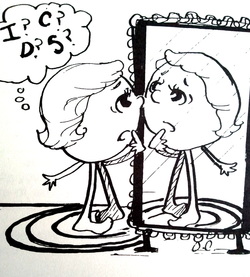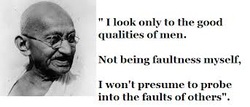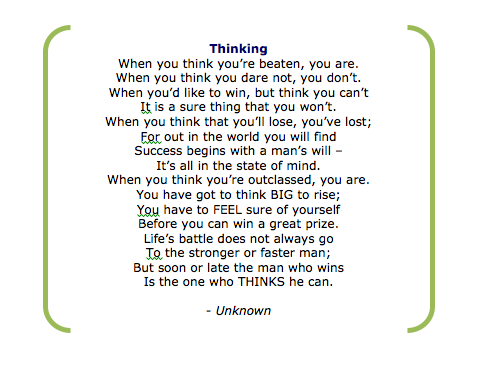 A friend of mine recently completed a leadership profile assessment report. After reading it, his comment to me was... Well it's scary to think a program can know you better than you know your self!! When I am working with clients, I hear this comment all the time. So many of us just haven't got a clue about who we are BEING in the world, or understand what drives our personality . That's why I love DISC so much. You see once you complete a DISC profile, you learn what NEEDS, EMOTIONS and FEARS are driving your behaviour. The information in your profile awakens you to how you interact with people. It is the key that leads to an understanding of the basic nature of what it is to be human – active, independent, loving, social, loyal, kind, intelligent and creative. Once seen and recognized, one has NO PROBLEM in relating to other people and getting the results each needs, wants... and deserves. I know my DISC style... now how do I apply it in my life? Once you understand that the results you are getting in life relate to your needs, emotions, fears and behavior, you then have the power to choose how you respond in the moment. If the result is not one that empowers you, then look to see what mindset or belief is driving that behavior. Look to see who you are BEING. Human beings are intelligent and emotional, and fundamentally need to interact with each other. Most of us do not choose to live out our life on a desert island. We need each other to BE in the world. Who we are BEING can be explained in three parts. The first part is our Intelligence Quotient or IQ – our aptitude, cleverness and how we use our brain. Then there is our Emotional Quotient or EQ – the beliefs, mindsets and feelings we have. And thirdly there is our People Literate Quotient our PQ – understanding and the knowledge we have about people. Put them all together we have our BEINGNESS QUOTIENT or BQ. Cultural, spiritual and religious beliefs also influence the three quotients. Life is about balance. When all three quotients are aligned and you are conscious of what drives your BQ you can then also understand how others relate. Which is where life STARTS... and STOPS!!!
0 Comments
 Have you ever come across people that leave a lasting impression in your life? You know, the ones that you may not have met in person but have influenced your thinking and how you are choosing to BE in the world. I often look to Mahatma Gandhi for wisdom. His gentle approach to life is testament to the fact that strength does not equal physical capacity. In the western world, we're taught that to be strong, we must be ferocious in attitude and vehemently go after what we want in life. His life story has proven that it’s possible to remain gentle in spirit, yet simultaneously command a huge amount of strength and respect. He says: “In a gentle way, you can shake the world.” In a world in which authority is valued over authentic leadership, I believe we have a lot to learn from the man who fought for a nation with his mind alone. Gandhi’s philosophy was not purely based on theory; instead he lived by rules of pragmatism. He practiced what he preached every day of his life. What an inspiring, authentic way to live! BEING authentic is the key, when it comes to style, know matter what style we are. If you own who you are BEING it is much easier to be authentic. The following Mahatma Gandhi quotes are some of my favourite and I see all the styles within them. See if you can to...
 Ever wondered why your staff never listen…? Perhaps what you are thinking is not what you said! There is more to communication than you hear… Why is it that sometimes it seems like your staff are never listening to you? And why is it that sometimes people just don’t get what it is you are trying to say? Most of us at some point in our lives have experienced the negative and positive effects our conversations have on ourselves and on others. The positive ones leave us feeling happy, contented and energized. Those conversations that don’t quite go the way we planned can leave us feeling discontented, unhappy and un-energized. Afterwards how many of us wish that we could have said it another way, added a key piece of information or done something differently? Let’s start looking at the art of communicating effectively…. Where does it all start? Communication starts with a thought. And these initial thoughts and ideas are made up of energy, whether positive or negative in nature. Noah St. John one of the key presenter’s in a book and DVD called “The Secret” calls these thoughts and ideas, thought-seeds. And we are planting these thoughts every minute, every hour and every day (whether we are aware of them or not). We send and receive so to speak whenever we are with people…. We are human walking radio antennas! People not only relate, respond and react to what we are saying, but to also what they feel and receive from us when we are speaking to them. Up until now 6 billion or so human beings have created the world as it is today. To do this everyone one of us has had about 90,000 thoughts a day! Yes that’s right about 90,000 a day! And these thoughts are made up of mindsets and beliefs that create certain kinds of behaviour and attitudes. Ninety percent of these mindsets and beliefs are stored in our unconscious mind - first developed in the period from 1895 to 1900 by Sigmund Freud, who theorized that it consists of survivals of feelings experienced during infantile life, that include our instinctual drives. And these mindsets and beliefs (thoughts) give off energy… The energy of thought When we communicate we not only verbalize words, but we also communicate judgements and mindsets we have about people we are speaking with, to them. These for the most part are not communicated verbally as they are held in our unconscious mind. Our unconscious mind lies below the level of our conscious mind. These judgements and mindsets held in our unconscious mind are hidden to us 90% of the time. However they are what drive our behaviour and our communication style! We are very competently unconscious at tapping into and using them. A good example of this is when we brush our teeth. We do not think about each action needed to brush our teeth, we just brush them! The same applies to the way we choose to, or not to communicate. Recall a time in the past when you have walked into a room where others have had an argument. Did it feel like the energy was so dense you needed a knife to cut the air with? This negative energy has been created by the people’s thoughts and dialogue that had previously been having the argument. On a more positive note think of a time when you have entered a room where people have been having lots of fun, the energy of the room will feel much lighter. So in other words not only do you communicate what you are consciously thinking about and verbalizing, but what is hidden away in the recesses of your unconscious mind. So if you are thinking negative thoughts about your staff or clients the bad news is they will be picking up on and responding to these thoughts! The good news is and lucky for you, is that they are probably unconscious to this fact. Not all of us are mind readers! It is the essence (energy) of what we are communicating that can inspire, lead and manage people effectively. And deepen our personal relationship with others. You see the words you speak do add to the experience for people who are listening, and give meaning through stories, but it is often the “essence” that we respond to when others are communicating with us. Remember a time when you came away from a conversation where you thought, “there is something about that person I really like”? But you can’t put your finger on what it was you liked about them. Well it was most probably the energy of their thoughts you were receiving, whilst you were listening to them speaking. Follow the tips below and notice your conversations start to improve. Become aware of what underlying beliefs stop you from communicating how you are feeling. Especially when you are frustrated or angry. When I was growing up as a child it was common for children to be sent to their room if they became angry. And for many years as an adult, I had the habit of going to my room if I became angry. Without being able to first express how I felt with whom I was angry with – not very helpful when having to manage a busy team of people, I might add! Connecting and responding = Affinity Affinity is all about being in relationship with people that we are speaking to. It’s about connecting and responding positively to people before we actually speak to them. Let me give you an example of this. Close your eyes and imagine that you are watching two horses as they greet each other for the first time. What would you see them doing as they approach each other? Horses touch noses and blow into each other’s nostrils to create connection and to cause a response in each other. After this happens they often neigh to each other for further communication (speaking). As adults we have become so unconsciously competent at speaking we forget that like horses we to display certain types of behaviours and have attitudes when communicating with people that they pick up on and respond to. Depending on the other person’s behaviours and attitudes, or for that matter, the way they physically look will influence how we choose to communicate with them and what it is we will share with them. How do you create affinity (connection/respond) with your staff and clients before speaking to them? Awareness Start by becoming aware of when you are reacting or resisting a conversation. This reaction and resistance will bring you out of affinity (energetically connecting) with the person you are talking with. Once affinity is lost communication becomes very difficult. Also limiting beliefs and mindsets stored in your unconscious mind often come to the surface of your conscious mind when you are in reaction and/or resistance. If you are aware enough to catch them you be given an insight about yourself or behaviour. Armed with this insight you have a chance to change the belief into a more positive one. Staying present and asking questions Everyone can have a slightly different meaning for a word so choose words carefully. If someone is struggling to understand an idea you are talking about check with them to see if their meaning for some of the key words they have heard means the same for them as it does for you. Stay present (in the moment) to the conversation, and clarify using questions if you don’t understand words that are being used. Our mind is easily distracted, especially if the conversation we are having does not particularly interest us. So it’s about choosing to stay engaged with the speaker. And it is all about being aware that your mind is drifting. Listening Learn the art of listening with intention to people you are speaking with. All of us have this inner voice inside our head that runs our conversations, so learn to turn this off while listening. I call it declutching from the mind by observing its chatter. Otherwise it will only take you away from being present to what the other person is saying. Have a listening focus – something to place your attention on. This will relate to something in the conversation the person is speaking to you about. It might be listening for how the person is feeling, or what it is they are happy about or afraid of. It is not usually spoken but is intangible - not seen by the eye. It will help you to stay present and focused while in a conversation. The essence of a story’s communication… Precious Gift… One day a wise woman who was traveling in the mountains found a precious stone in a stream. The next day she met another traveler who was hungry, and the wise woman opened her bag to share her food. The hungry traveler saw the precious stone and asked the woman to give it to him. She did so without hesitation. The traveler took the stone and left rejoicing at his good fortune. He knew the stone was worth enough to give him security for a lifetime. But, a few days later, he came back to return the stone to the wise woman. "I've been thinking," he said…. "I know how valuable this stone is, but I give it back in the hope that you can give me something even more precious. Give me what you have within you that enabled you to give me this stone." Sometimes it's not the wealth you have but what's inside you that others need. And so I would like to leave you with a question… What was really communicated in this story…? And how could you apply the lesson learned with your staff? Until next time happy talking! What is the difference between management and leadership?
And when is it appropriate to manage or lead your staff? The increasing rate of change today in a business environment is placing the emphasis on individuals to step more into a leadership role. Gone are the days where you could just turn up for work and manage your team. Today employees are looking for a work environment that gives them a sense of safety, ways to be creative and also a sense of community or team. Whereas in the past, managers were expected to maintain the status quo in order to move ahead, leaders today must be visionary, being both learners and teachers at the same time. Leadership requires you to have a strong sense of ethics and you must be able to work towards building and teaching integrity in your business. The biggest difference between being a manager and a leader is in the way you motivate, inspire and communicate with your staff. Many business owners by the way are both. In small businesses owners often need to manage the day to day operations, as well as lead and inspire a team to keep morale and productivity up. Holding and translating to staff the bigger picture for growing the business and for achieving strategic goals, requires leadership thinking. Personality style and traits of a leader… If you are looking to develop your leadership skills first you must understand and become aware of what traits, attitudes and behaviour a leader would be able to demonstrate. Then look at developing these within yourself. In 1954, Raymond Cattell, developed and designed the Leadership Potential equation, leading the way in the field of personality assessment. I have taken from Cattell’s Leadership Potential equation a number of leadership and personality traits I feel are important to have as a leader, these are:
Where to start when developing your leadership qualities… Some of you might be thinking that the list seems rather long and how can one person have all of these traits within them? Leaders are rarely (if ever) born. Circumstances and the experiences we have in life, play a major part in the developmental process of any leader. To become more of a leader, work on developing those traits in your personality that you feel are not present or that you think are your weakest. Personal leadership traits play a major role in determining who will and who will not be comfortable leading others. However, it's important to remember that people can adapt their style and change. It will also depend on your beliefs relating to leadership. Some years ago in a conversation with a colleague I was told that I would make a great leader. This surprised me as I had never thought of myself as a leader. Further on in the conversation I uncovered a number of beliefs that I had that related to being a leader. To me if you were a leader you would either eventually be put in jail (Neilson Mandela) or killed (a number of presidents around the world)! Stepping into a leadership role definitely was not something that I believed to be safe! However once I become aware of these beliefs I was able to change them. I would encourage you to sit down somewhere quiet. Take a few moments to think about some of your beliefs (what is true for you) you might have that would stop you from becoming a leader, and write them down. These thoughts are statements, usually your first ones, before you start to rationalize your thinking. And they don’t necessarily have to make sense either. At a rational thinking level I also believed that not all leaders were put in jail or killed. The mind both unconscious and conscious does not rationalize what is real or not real. It just believes what you tell it! And you create your life from these thoughts. So accessing what you believe leadership to mean first is critical in the change process. Once you have your list then you can start to become aware of what you believe to be true and choose to change how you think. Some styles find leadership easier than other styles… In the DISC psychometric profile that I have spoke about in a previous article, people with the more dominant style “D” find it easier to lead as they naturally have traits of problem solving, can think of the big picture and can make things happen. However these individuals still need to develop their people skills and empathy for others, qualities a leader would have. And they can at times be very controlling, and find working in a team rather challenging. For instance, if you have all of the basic leadership traits but do not consider yourself very much of a "people" person, taking classes or reading books on empathy could be away of developing this trait. On the other hand, if relating to others has always come naturally to you, but you have trouble making decisions, learning how to develop your problem solving skills could help develop the trait of problem solving. Once you have written your list of what stops you from becoming a leader, then look to see what traits are missing in your style based on Cattell’s list or that are the weakest. And then design your development goals. These goals could include participating in some personal development programme, reading books, working with a life/business coach or finding a mentor. Remember a development goal must be able to give you an awareness of what is stopping you from becoming a leader. It must be able to give you support or new information that creates change in your attitude, beliefs or behaviour. So at the end of the day leadership comes from within, and starts with a choice. Some people may be thrown into the leadership role and some may choose it willingly. Whether you choose to manage or lead your staff is up to you. In my experience as a business owner, facilitator and coach, today people are looking for leadership more than ever. I have learnt that being a leader can leave one with a sense of making a difference, and pride in knowing that you have contributed to the achievement of others. The first step to becoming a leader is to become aware of what you are thinking. I would like to leave you with a poem written by an unknown author that describes a part of the leadership journey beautifully. Enjoy… |
AuthorSandra is very passionate about supporting others to be the best they can be through sharing her stories and experiences she has gained along the way... Categories
All
Archives
March 2022
|
Partner with PeopleSmart
© Copyright 2024 - PeopleSmart Enterprises NZ Ltd. All Rights Reserved.
Privacy Policy


 RSS Feed
RSS Feed